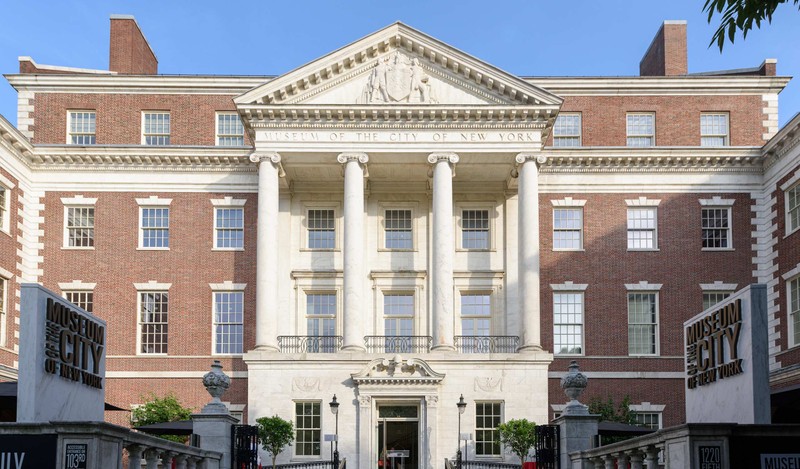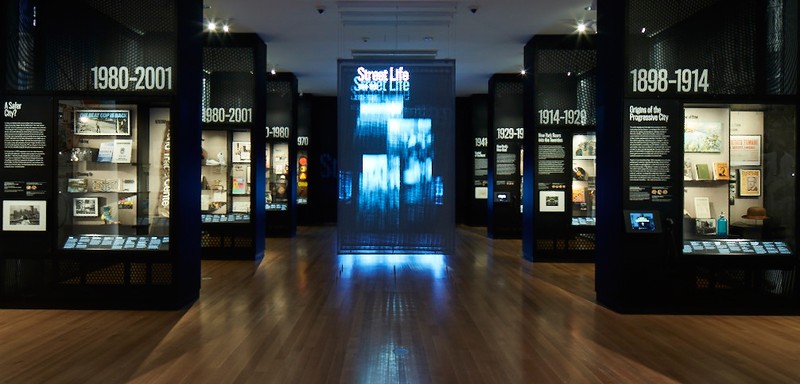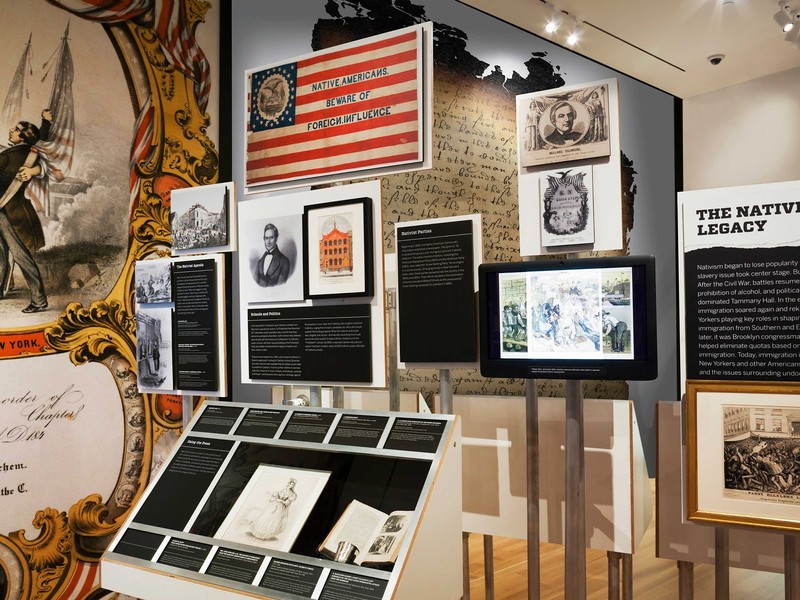Museum of the City of New York
Introduction
Text-to-speech Audio
Images
The Museum of the City of New York was established in 1923. The current building, designed in a Georgian Colonial-Revival style, was constructed in 1929-1932. Image obtained from the Museum of the City of New York.

One of the museum's new most popular features is the exhibit "New York at Its Core," which chronicles the 400-year history of the city. Image obtained from the Museum of the City of New York.

The museum also presents a variety of other temporary and permanent exhibits, such as this one on activism. Image obtained from Pentagram.

Backstory and Context
Text-to-speech Audio
The Museum of the City of New York was formally established in 1923 by Henry Collins Brown, a Scottish American writer and journalist who wrote numerous books on the history of New York City. Brown was very passionate about the story of New York and during the 1920s was perhaps the city’s most well-known historian. He was reportedly dissatisfied with the New-York Historical Society, which he regarded as too privileged and elitist, so he created his own private, non-profit organization to preserve and present the New York’s history in a more populist manner. Brown first set up the museum inside the Gracie Mansion, which would later become the official residence of the New York City mayors. In 1926 the museum board replaced Brown (for reasons unclear) and began looking for a new location. The city donated a plot of land on Fifth Avenue from 103rd to 104th street, and the museum appointed Joseph H. Freelander to design a new building. Construction of the brick and marble, Georgian Colonial-Revival style structure began in 1929 and was completed in 1932. Sculptor Adolph Alexander Weinman also contributed two statues of Alexander Hamilton and DeWitt Clinton, which were displayed on the exterior. The new museum proved very popular; by 1938 it was averaging 200,000 visitors annually.
The museum rapidly expanded its collection, and acquired thousands of new artifacts. It soon became clear that the building would have to be expanded, but it would be decades before any efforts came to fruition. In 1967 the museum was designated a New York City landmark. In 1982 it was the recipient of The Hundred Year Association of New York’s Gold Medal Award for its contributions to the city. During the late 1980s and early 1990s the museum hired the Polshek Partnership Architects to create plans to construct a new addition, but financial issues made any expansion impossible. By the early 2000s the museum was experiencing a decline in attendance and began contemplating a move to a more suitable location. Mayor Rudy Giuliani proposed to have the museum move into the former Tweed Courthouse, near City Hall. However the next mayor, Michael Bloomberg, rescinded the offer and gave Tweed Courthouse to the Department of Education instead. A deal to merge with the New-York Historical Society also fell through. Left with no other options, the museum decided to remain put. In 2006 it began a multi-phase renovation project that included building a scaled-down version of the addition designed by Polshek, a two-story contemporary glass gallery. The renovations also included the addition of new conservation storage for artifacts, and the creation of complete disability access. The expansions and implementation of new programming has led to a new increase in visitors.
Today the Museum of the City of New York contains a vast collection of over 750,000 artifacts, including artwork, photographs, prints, theatrical pieces, and other objects connected to the history of New York. Notable items include some of Eugene O’Neill’s handwritten manuscripts, a dollhouse belonging to Carrie Walter Stettheimer, and a suit worn at George Washington’s Inaugural Ball. In 2016 the museum unveiled its first permanent exhibit, “New York at Its Core,” which has become very popular. The 8,000 square foot exhibit, taking up the entire first floor, covers the complete history of New York City spanning over 400 years the first ever to do so. The success of the exhibition earned the museum a $10 million donation in 2017 from the Thompson Family Foundation, the largest contribution ever received by the museum. The museum also presents temporary exhibits on various aspects of the city’s history, which have included sports, women’s suffrage, politics, fashion, theater, activism, and diversity. The museum regularly hosts various lectures and performances as well. A digitization project is currently underway to make the museum’s collection of paintings, prints, and photographs available to the public online.
Cite This Entry
Straley, Steven Cody. "Museum of the City of New York." Clio: Your Guide to History. April 24, 2018. Accessed March 18, 2025. https://theclio.com/tour/881/22
Sources
“About.” Museum of the City of New York. Accessed April 24, 2018. http://www.mcny.org/about
Gray, Christopher. “STREETSCAPES/The Museum of the City of New York; Preserving the Past, Planning the Future.” New York Times. November 6, 2005. Accessed April 24, 2018. https://www.nytimes.com/2005/11/06/realestate/streetscapesthe-museum-of-the-city-of-new-york-preserving-the.html
Moynihan, Colin. “Museum of the City of New York Receives Record Gift.” New York Times. January 30, 2017. Accessed April 24, 2018. https://www.nytimes.com/2017/01/30/arts/design/museum-of-the-city-of-new-york-10-million-gift-thompson-family.html
Morrone, Francis. “New Life for the Museum of the City of New York.” New York Sun. April 28, 2008. Accessed April 24, 2018. https://www.nysun.com/arts/new-life-for-the-museum-of-the-city-of-new-york/75402/
MuseumofCityofNY. “This is the Museum of the City of New York” (video). Posted August 21, 2017. Accessed April 24, 2018. https://m.youtube.com/watch?v=B2z7vjY3uOc
Pogrebin, Robin. “Museum of History Unveils Its Future.” New York Times. August 11, 2008. Accessed April 24, 2018. https://www.nytimes.com/2008/08/12/arts/design/12muse.html?pagewanted=2&_r=1&ref=design
Pogrebin, Robin. The City Changes. Its Museum Will Too.” New York Times. September 28, 2006. Accessed April 24, 2018. https://www.nytimes.com/2006/09/28/arts/design/28pols.html
Santora, Marc. “Museum of City of New York Names Director.” New York Times. September 24, 2002. Accessed April 24, 2018. https://www.nytimes.com/2002/09/24/nyregion/museum-of-city-of-new-york-names-director.html
Image 1: http://www.mcny.org/about
Image 2: http://www.mcny.org/event/p-credit-course-new-york-its-core-examining-our-citys-past-present-and-future-0
Image 3: https://www.pentagram.com/work/activist-new-york/story#19479

